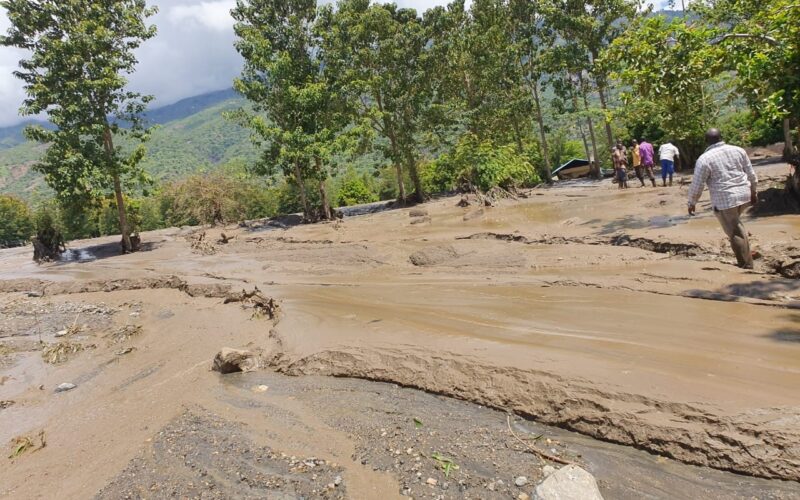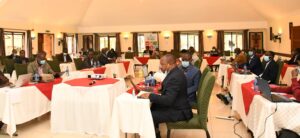
In Kenya, forest degradation and deforestation has contributed to about a third of climate calamities such as landslides, mudslides and floods. These calamities are mainly attributed to soil erosion, which is caused by cutting trees and forests, driven by increasing human population pressure on the resource base and overreliance on forest land for agricultural production. Forests and trees play a major role in stabilizing soils, storing water in catchments, and naturally controlling its flow downstream. Sadly, massive deforestation in the Counties of West Pokot and Elgeyo Marakwet is contributing to increasing landslides, mudslides, and floods.
In November and December 2019, less than a year ago, West Pokot, Elgeyo Marakwet and surrounding areas were affected by floods and mudslides due to heavy rains. Lives were lost, property destroyed, and more than 100 families were displaced from their homes according to West Pokot County Officials. Long rains are currently being experienced across Kenya, with the same areas being hit once again. These mudslides and floods have so far claimed the lives of more than 20 individuals in the County of Elgeyo Marakwet alone. The destruction of houses has led to families seeking refuge in schools and churches – Wewo Catholic Church and Sambalat School – with little or limited access to basic needs such as water and food. The Kenya Meteorological Department is continuing to issue warnings of projected enhanced rainfall beyond the normal expectation in the region and in other parts of the country.
This catastrophe comes at a time when Kenya, like many countries, is desperately trying to flatten the curve of the COVID-19 pandemic. The Kenyan Government has put urgent in place measures to address the COVID-19 pandemic and to reduce the negative impact on lives and the economy. Sadly, in addition to the current pandemic, communities in West Pokot and Elgeyo Marakwet are being gravely affected by the prevailing landslides, mudslides and floods.
“We are putting our heads together and organizing ourselves to deal with a clearly impending challenge,” Interior Cabinet Secretary Fred Matiang’i said on 20 April 2019 at a joint press briefing, with Cabinet colleagues from Devolution, Environment and Energy. He added that “we are working jointly to see how we can effectively support the Kenyans camping in schools and other facilities to avoid the negative consequences of the rains.”
Elgeyo Marakwet County is home to two forest ‘Water Tower’ ecosystems, namely, Kaptagat and Cherangany. The County, according to the Ministry of Environment and Forestry, hosts the second largest forest cover in Kenya of 37.6% and more. The Kaptagat and Cherangany Water Towers are a source of many rivers that form the main water divide running along the Escarpment – Lake Turkana, Lake Victoria Basin, Kerrer and Kerio Rivers. Unfortunately, these forests have been degraded due to illegal encroachments, agriculture, and over grazing.
As demonstrated by the recent landslides and flooding, the County continues to face challenges of soil erosion largely due to deforestation. The escarpment area, in particular, is vulnerable due to geological instability that makes it susceptible to landslides, which creates the risk of serious harm to human beings and livestock downstream. The County Government of Elgeyo Marakwet has taken proactive measures to put in place laws and policies to protect the forests, reduce forest degradations, and enhance conservation efforts to secure present and future livelihoods of local and indigenous communities through sustainable management for the forests and all vulnerable landscapes in the county.
With the support of the National REDD+ Process led by the Ministry of Environment and Forestry financed by the Forest Carbon Partnership Facility (FCPF) through UNDP, the County Government of Elgeyo Marakwet embarked on a participatory process to develop a forest conservation and management policy, as well as a bill and accompanying regulations. These will enhance the roles of the County Government, local and indigenous communities, and other stakeholders in forests and soil conservation in the County.
“The escarpment has been degraded over the last years due to encroachment and cutting trees for charcoal…. having laws in place will help us solve these issues [soil erosions, degradation] and help us in management of our forests well.” Abraham Barsosio – County Executive Committee Member – Environment.
To ensure the success of the specific policies and legislation put in place on forest conservation, as well as climate change adaptation and mitigation, full participation and engagement of communities specifically the indigenous peoples and local communities will be needed. Additionally, with the forestry policy and legislation in place, the County will be able to establish programmes that protect both the soil and water catchments, promote tree planting, reduce erosion and eventually avoid future mudslides.
It is clear that our lives and the environment are interconnected. By urgently addressing the issue of deforestation and forest degradation, climate change induced catastrophes such as the floods and mudslides being experienced in West Pokot and Elgeyo Marakwet can be averted. UNDP continues to work closely with the County and other partners to put in place policy measures that will enhance forest conservation and management for sustainable development and the preservation of lives.


